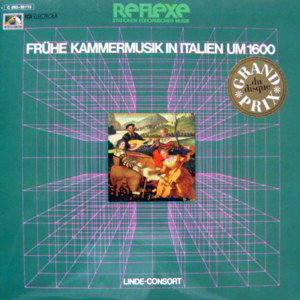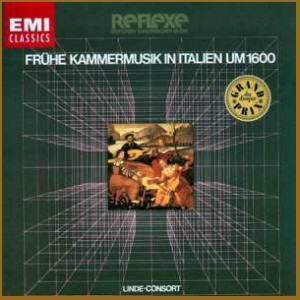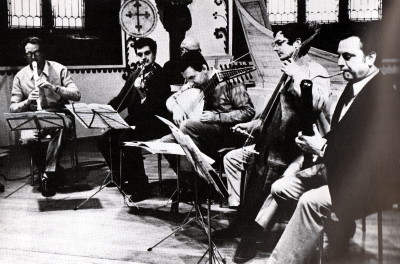 |
1 LP -
1C 063-30 110 - (p) 1973
|

|
| 1 CD - 8
26477 2 - (c) 2000 |
|
FRÜHE KAMMERMUSIK IN ITALIEN
UM 1600
|
|
|
|
|
|
Giovanni
Gabrieli (1557-1812)
|
|
|
Madrigal
"Lieto Godea sedendo" (Fassung
für zwei instrumente, 1601) -
Laute, Cembalo
|
2' 39" |
|
Girolamo
Frescobaldi (1583-1643)
|
|
|
| Aus "Primo libro
delle canzoni... per ogni sorti
d'istromenti..." (1618) |
|
|
| - Canzon per
due Canti - Blockflöte,
Violine, Cembalo, Gambe |
3' 23"
|
|
| - Canzon per
due Bassi - Gambe,
Fagott, Positiv |
4' 46" |
|
| - Canzon per
Canto e due Bassi - Blockflöte, Gambe,
Fagott, Positiv |
2' 26" |
|
| Girolamo
Frescobaldi (1583-1643) |
|
|
- Toccata -
Violine, Cembalo,
Gambe
|
3' 38" |
|
| Massimiliano
Neri (17. Jahrhdt.) |
|
|
| - Sonata à 4
(1651) - Blockflöte,
Violine, Gambe, Fagott |
7' 16" |
|
|
|
|
| Martino
Pesenti (um 1600-1648) |
|
|
| Aus "Correnti,
Gagliarde e Balletti... per
sonarsi nel Clavicembalo e altri
Stromenti..." (1645) |
|
|
| - Nr. 10
Balletto Vigesimo - Blockflöte,
Cembalo |
1' 09" |
|
| - Nr. 4
Balletto Quinto - Gitarre,
Cembalo |
1' 28" |
|
| - Nr. 3
Balletto Quarto - Cembalo
solo |
1' 24" |
|
| - Nr. 6
Gagliarda Decima - Violine, Cembalo |
1' 30" |
|
| - Nr. 2
Gagliarda Seconda - Gitarre,
Cembalo |
1' 18" |
|
| - Nr. 10
Balletto Vigesimo - Blockflöte,
Violine, Cembalo, Gitarre |
1' 11" |
|
| Dario
Castello (17. Jhrhdt.) |
|
|
-
Sonata "per Soprano solo"
(1644) - Blockflöte,
Gitarre, Gambe
|
4' 50" |
|
| Girolamo
Frescobaldi (1583-1643) |
|
|
| Aus "Primo libro
delle canzoni... per ogni sorti
d'istromenti..." (1628) |
|
|
-
Due Canzoni per Canto solo -
a) Violine,
Positiv - b) Blockflöte,Gitarre
|
6' 43" |
|
| Gian Paolo Cima (um 1570) |
|
|
| -
Sonata in d für Violine und Basso
continuo (1610) - Violine, Cembalo,
Gambe |
4' 11" |
|
|
|
|
| LINDE-CONSORT |
|
| -
Hans-Martin Linde, Blockflöte |
|
| -
Herbert Hoever, Barockvioline |
|
| -
Walter Stiftner, Barockfagott |
|
| -
Michael Jappe, Viola da gamba |
|
| -
Konrad Ragossnig, Gitarre, Laute |
|
| -
Eduard Müller, Cembalo,
Orgelpositiv |
|
|
|
|
|
Luogo
e data di registrazione |
|
Sankt
Martins-Kirche, Basel (Svizzera) -
giugno 1972 |
|
|
Registrazione: live /
studio |
|
studio |
|
|
Producer / Engineer |
|
Gerd
Berg / Johann Nikolaus Matthes
|
|
|
Prima Edizione LP |
|
EMI
Electrola "Reflexe" - 1C 063-30
110 - (1 lp) - durata 48' 01" -
(p) 1973 - Analogico |
|
|
Prima Edizione CD |
|
EMI
"Classics" - 8 26477 2 - (1 cd) -
durata 48' 01" - (c) 2000 - ADD |
|
|
Note |
|
- |
|
|
|
|
|
 Around
the year 1600, Giovanni
Gabrieli’s spring madrigal
“Lieto Godea” (Concerti, 1587)
was enjoying great popularity
in a number of European
countries. This is borne out
by the various arrangements of
it by Phalèse
(1591), Banchieri (1596) and
Schütz
(1619). In
his 111th Psalm, the latter
used it in an instrumental
setting as an “Imitazione
sopra ‘lieto godea’ di G.
Gabrieli” and in a vocal
setting with the German text
of “Glory be to the Father.”
There is also a version for
two lutes by Joachim van den
Hove (1601). Gabrieli’s note
“per cantar e sonar” refers
specifically to the tradition
of vocal and/or instrumental
performance. The “cori
spezzati” style - an
alternation with “interrupted
choirs” - comes out
particularly clearly when two
different kinds of instrument
are used. That is why the lute
and the harpsichord are set
off one against the other in
this recording. Around
the year 1600, Giovanni
Gabrieli’s spring madrigal
“Lieto Godea” (Concerti, 1587)
was enjoying great popularity
in a number of European
countries. This is borne out
by the various arrangements of
it by Phalèse
(1591), Banchieri (1596) and
Schütz
(1619). In
his 111th Psalm, the latter
used it in an instrumental
setting as an “Imitazione
sopra ‘lieto godea’ di G.
Gabrieli” and in a vocal
setting with the German text
of “Glory be to the Father.”
There is also a version for
two lutes by Joachim van den
Hove (1601). Gabrieli’s note
“per cantar e sonar” refers
specifically to the tradition
of vocal and/or instrumental
performance. The “cori
spezzati” style - an
alternation with “interrupted
choirs” - comes out
particularly clearly when two
different kinds of instrument
are used. That is why the lute
and the harpsichord are set
off one against the other in
this recording.
The traditional madrigal style
- with its generally simple
declamation of the text -
comes through even in an
instrumental arrangement of
this kind. There is a mutual
balance between the parts; the
melodic line is diatonic and
moves within fairly narrow
limits; the harmonic sequences
are determined by the logical
manner of composition. But
around 1600 a new style,
originating in Italy,
began to conquer Europe. The
instruments were now given
individualistic treatment, and
the basso continuo supported
solo passages of a novel kind.
New forms of composition and
new ways of playing came into
fashion. The “stilo concitato"
invaded instrumental music,
too. The savouring of
contrasting, rapidly changing
emotions called among other
things for a “gradual
crescendo and diminuendo of
the note” and the use of
“sounds both cheerful and
sombre” (Pietro della Valle,
1640). These were both taken
over into instrumental from
vocal music. Expressiveness
was now increased by the use
of a chromatic as well as a
diatonic melodic line. The
scope of the instrumental
sections was extended in both
the upper and lower ranges.
The depiction of the various
emotions was given harmonic
emphasis by unexpected
modulations. The solo pieces
now being written were no
longer merely “useful and
handy” or “delightful to sing
and playable on all sorts of
instrument." The heightening
of expression brought with it
the development of a personal
style of execution in which
“each performer displayed
virtually a manner of his own
according to his talents”
(Tobias Michael, 1637).
The new instrumental style
developed step by step. As
late as 1618/19, Michael
Praetorius attempted to define
the difference between Sonata
and Canzone by saying that
“Sonatas are grave and
magnificent in the manner of
Motetts, whereas Canzoni are
fresh, frolicsome and fleet,
with a wealth of black notes.”
However, this distinction
applies at best only to the
first phase of the new epoch.
Soon there were frequent
overlappings between the two
forms. Around 1620 they were
both marked by frequent
changes of tempo and
expression.
A special characteristic was
declamatory Adagio sections
requiring changes of tempo
(cf. Frescobaldi, Castello). In 1596
Lodovico Zacconi, a champion
of the traditional style of
performance, was still
demanding strict observance of
the tempo. This also applied
to passages of
demi-semiquavers, which he
said had “only recently been
invented” for instrumental
music. But Giulio Caccini in
1602 and Girolamo Frescobaldi
in 1614, among others, were
describing modifications of
tempo as absolutely essential
for good performance.
The Sonata was brought more in
line with the Canzone by a
further increase of the
virtuoso element in the new
instrumental style, expressed
in headlong gallops, huge
leaps, changes of rhythm,
Lombardic figures and
embellishments of various
kinds (cf. Castello, Cima). In the
Toccata (cf. Frescobaldi’s
Toccata per Spinettino e
Violino) the proximity of
improvisation is made apparent
by the free rhapsodic sections
standing in contrast to
running passages and broken
figuration. In
other compositions, old and
new are combined in an
original fashion. Imitative
writing in the older Canzone
style and novel Capriccio
sections with witty changes of
tempo are boldly contrasted
with each other (cf. Neri,
First and Third Movement).
Traditional rhythmic patterns
are set off against unusual,
fluctuating, syncopated ones
(Second Movement). By
imitating a melodic line at
intervals of a fifth in the
various parts, Frescobaldi,
too, introduced elements of
the older polyphonic style
into the new monodic one.
The collection of Martino
Pesenti acquaints us with
delightful examples of the
dance music of the time. In it,
the dances are presented at
random, so it is for the
individual to choose the order
of the Correnti, Gagliardi and
Balletti. Incidentally,
the use of such keys as B
minor and G sharp minor is
worth noting, as these were
uncommon at that time. Only
the treble and bass parts are
noted down, the composer
allowing complete freedom of
instrumentation by his remark
“per sonarsi nel Clavicembalo
e altri stromenti.”
The choice of instruments is
also open in most of the other
works in this recording. The
use of recorder and viola da
gamba in the previous period
continued into the new one.
The violin, coming into
fashion in the early Baroque
era, was given a variety of
tasks. The use of a bassoon
for the continuo, and the fact
that it was occasionally
preferred to a cornet for the
melodic line, are often borne
out by contemporary writers
(e. g. Buonamente in 1626 and
de Selma in 1638). Under
Spanish influence, the guitar
came to Italy to rival the
familiar lute. And finally,
the harpsichord and chamber
organ were used both solo and
continuo purposes.
Hans-Martin
Linde
Translation
by David Potter
Das Linde-Consort
Linde Consort is a free group
of instrumentalists working,
above all, in Basel - some of
them teaching at the Schola
Cantorum Basiliensis. Numerous
recordings and concerts proved
the rich variety of differing
cast this ensemble disposes
of.
Part of the group’s work is
dedicated to the performance
of baroque compositions for
wind instruments and strings.
This includes chamber music
casts as well as music for
chamber orchestra.
Some of the instruments used
are originals from the 18th
century, some are copies of
historic examples. The group
specialises in a performance
in ‘Broken Consort’. For this,
a model cast as described by
Morley (‘Consort Lessons’) is
gathered, i. e. violin, bass
recorder, viola da gamba,
lute, cittern and pandora.
Linde Consort also performs
music for recorder ensembles
with or without thorough-bass.
In
Europe and overseas critics
unanimously confirmed that
Linde is one of the most
outstanding flutists of our
days. He conducted and
directed various ensembles in
concerts (as e. g. at the 1970
Heinrich-Schütz-Festival
in Herford or the English
Chamber Orchestra in 1972) and
recordings (as e. g. the
concert group of the Schola
Cantorum Basiliensis).
|
|
|
EMI Electrola
"Reflexe"
|
|
|
|

